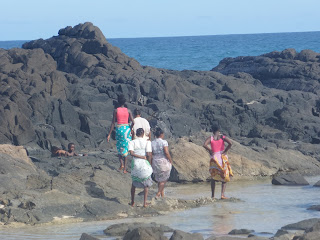by Daniel
Amazing.
Stunning. Breathtaking. Otherworldly. Unforgettable. And many more such
attributes. Parc National Marojejy was definitively a highlight on that trip to
Madagascar. It is remote, it is pristine, you are quite lonely yet you don’t
have to go beyond your limits for an exciting adventure.
As a matter of
fact Marojejy is that little visited that you have to inform the National Park
in advance. If you just show up there’ll propably be nobody to receive you. We
were lucky that we stumbled across the tourist information in Sambava so they did the reservation for us.
The next day we
took an early Taxi-Brousse to Andapa and asked to be let out on the way. The NP
office is right beside the street. We paid the entrance fee (45.000 Ar p.P. per
day) and our guide (30.000 Ar per day) and set off.
There’s only one
trail leading into the national park, so you will have to backtrack on your way
back. First we passed two villages and
stunningly peaceful pastoral landscapes with small terraced hills filled with rice
paddies and the vast Massif de Marojejy hiding behind foggy mist in the
distance. Crystal clear streams flow from the mountains and fruit-laden lychee
and mango trees line the path. Every now and then there’s the sweet scent of
vanilla that is grown as a cash crop by many local farmers and in the plants
supporting the vanilla beans chameleons in all sizes and colours can be
spotted.
About five
kilometres from the office you reach the actual boundaries of the NP. Our
guide, Moses, was a very knowledgeable person. He would explain historical, geological
and botanical wonders to us and every now and then joke about his name (like
Moses being one of the first guides in history) or anything else. A truly great
personality and although he wasn’t the youngest of persons he was remarkably
fit.
When you enter
the jungle, you really enter a different world. The jungle in Marojejy is
completely untouched, it is thick and absolutely impenetrable be it not for the
well kept trail. You need a trained eye for spotting animals since they are
masters in the art of camouflage – from the myriad of frogs (you always hear
them but rarely see them) to tiny and monstrous insects.
There are three
basic camps in the park at different levels of altitude and each set in a
spectacular location near rivers that are clean enough to unproblematically
drink from. Since we arrived really early we had enough time to dip into a
natural pool under a small waterfall (a welcome refreshment after a long and
sweaty ascent) before having a break at the first camp. After some coffee ramen
we continued to the second camp.
One of the
reasons for visiting Maagascar was Frieda’s curiousity abut meeting Tenrecs.
Tenrecs are best compared to what we know as hedgehogs and while there are two
species of hedgehogs worldwide, there are around 30 species of Tenrecs on
Madagaskar. Although we were told that the time of the year was not good for
spotting them (and they are also shy as hell) we stumbled upon a mother and her
two babies. And it was Frieda who spotted the small family. The babies immediately
followed their instict and ran off but the mother stayed where she was ready to
defend her babies even against those huge and evil human creatures. When we
tried to snatch some pictures she would turn out her spiky backside and attack
everything that came near her. What courage! And what an encounter.
We reached the
second camp in the late afternoon. The second camp is on
a steep slope bordering a different kind of mountaineous rainforest with amazing
views of the towering cliffs of the surrounding mountains. From here the path
becomes more like a climbing expedition if you decide to make it to the summit.
On the second day
we woke up very early because Moses had told us that we might be able to see
the Silky Sifaka, a big silk white lemur also called the Angel of the Forest.
It is an endangered species and the group that lives around camp inhabits an
area of more than 60 hectares – a sighting is by no means guaranteed and we
prepared for another long walk. However, less than a kilometer from camp our
guide heard their distinct noises. High up in the trees they were swinging in
the branches but away from us. So we ran down a muddy slope trying to catch some
more glimpses. Eventually they rested in a treetop and we could get some
spectacular photos. Standing there amazed and excited as we were we did not see
that one of the Sifakas approached us from behind. It had silently climbed down
a tree and watched us. When we turned around our eyes met. It looked at each of
us intently from a distance of maybe three metres. Nobody dared to breathe.
When we finally made a slow move it merely changed the tree watched us for
another 30 seconds and then disappeared into the heights – a moment of
intensity that really is a privilege. Dazzled and happy we returned to our camp
for breakfast. Even our guide was silent and each of us deeply moved by that
encounter.
Still, we had to
return in order to get back to Sambava on the same day. With a little detour to
impressive Cascade Humbert we came into a tropical rainstorm that not only left
us soaking wet but also battling with an extremely slippery path, clouds of
mosqitoes and dozens of leeches that tried to make their way to some sweet
human blood. After a breakless five hour walk we came out of the national park
(and out of the rain) and hurried back to the main road where we caught a late Taxi-Be back to Sambava.




















































